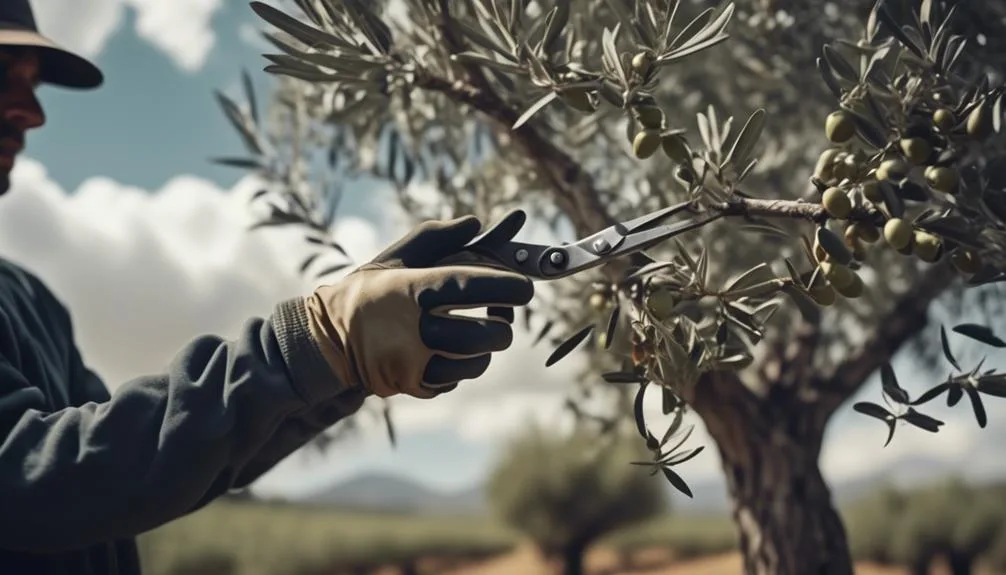Olive trees may seem tough, but they need some help to survive the winter. From trimming to keeping pests away, there are things you can do to protect your olive trees and help them grow strong in the spring.
In this article, we'll cover the essential steps for preparing your olive trees for winter. By the end, you'll know exactly how to ensure your olive trees come back healthy when the warm weather returns.
Key Takeaways
- Pruning and trimming olive trees before winter helps maintain their health and shape while preventing potential issues during the colder months.
- Using trimmed branches as mulch around the base of the tree provides soil insulation, moisture retention, weed suppression, and enriches the soil with essential nutrients.
- Wrapping olive trees with breathable fabric or burlap from the base upward helps insulate them from harsh cold weather without restricting their growth.
- Monitoring soil moisture, adjusting watering schedules, and regularly inspecting for pests and diseases are important strategies for ensuring the survival and health of olive trees during winter.
Pruning for Winter Protection
To prepare your olive trees for winter and protect them from potential damage, it's essential to engage in proper pruning techniques. Pruning helps maintain the overall health and shape of the tree while also preventing potential issues during the winter months.
Start by removing any dead or diseased branches, as these can become vulnerable to winter weather and may cause further harm to the tree. Additionally, thin out the canopy to promote better air circulation, which can help prevent the growth of mold or mildew.
It's important to avoid heavy pruning in late fall, as this can stimulate new growth that may not have time to harden off before winter.
Mulching to Insulate Roots
Prune the olive tree branches and then use the trimmed material as mulch to insulate the roots during winter. Mulching benefits the olive tree by providing soil insulation, moisture retention, and weed suppression. The layer of mulch acts as a protective barrier, shielding the roots from extreme temperature fluctuations and frost. It also helps maintain a more stable soil temperature, preventing the roots from freezing during cold spells. The decomposing mulch enriches the soil, providing essential nutrients to the olive tree roots. Here's a visual representation of how to properly mulch around your olive tree:
| Layer | Material | Depth |
|---|---|---|
| Bottom | Composted leaves | 2-3 inches |
| Middle | Chipped branches | 3-4 inches |
| Top | Straw or hay | 2 inches |
Wrapping for Cold Weather
Consider how wrapping your olive tree can protect it from the harsh effects of cold weather. Proper wrapping techniques and insulation materials are essential for safeguarding your tree during the winter months. Here are three key points to keep in mind:
- Wrap from Bottom to Top: Start wrapping from the base of the tree, ensuring that the entire trunk is covered. Use breathable fabric or burlap to allow air circulation while providing insulation.
- Secure the Wrapping: Ensure that the wrapping is secure but not too tight to allow for growth. Use twine or cloth strips to hold the material in place, avoiding damage to the tree.
- Choose Insulation Materials Wisely: Consider using materials like frost blankets, old blankets, or specialized tree wraps designed to provide insulation and protection from freezing temperatures.
Watering Strategies for Winter
As winter approaches, adjusting your watering schedule for your olive tree is crucial to ensure its health and survival during the colder months.
During winter, it's essential to monitor soil moisture to prevent overwatering, which can lead to root rot, or underwatering, which can cause stress to the tree.
Before the first frost, make sure the soil is moist but not waterlogged, as excess water can freeze and damage the roots.
Once the ground starts to freeze, reduce watering to prevent excessive moisture in the soil.
Additionally, consider using mulch around the base of the tree to help maintain soil moisture and provide root protection.
Pest and Disease Prevention
To ensure the health and resilience of your olive tree through the winter, it's important to be vigilant about preventing pests and diseases, particularly as your watering routine shifts with the changing season. Here are three essential strategies for integrated pest and disease management and soil health maintenance:
- Regular Inspection: Regularly inspect your olive tree for signs of pests or diseases such as scale insects, olive fruit fly, or fungal infections. Early detection allows for timely intervention and prevents the spread of these issues.
- Proper Pruning: Prune any dead or diseased branches to maintain the overall health and shape of the tree. This helps in preventing the spread of diseases and improves air circulation within the canopy.
- Soil Maintenance: Manage the soil health around the tree by avoiding waterlogging and ensuring proper drainage. Additionally, consider using organic mulch to improve soil structure and promote beneficial microbial activity.
Conclusion
In implementing these simple steps to prepare your olive trees for winter, you have set the stage for their resilience and health during the colder months.
By pruning, mulching, wrapping, and maintaining proper care, you have taken the necessary measures to ensure their well-being.
Now, as the olive trees weather the winter, you can look forward to their vibrant emergence in the spring, knowing that you have provided them with the best possible foundation for success.

